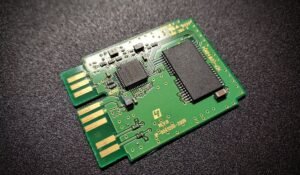Generative AI Image Use Cases
With the advancements in generative artificial intelligence (AI), the field of computer vision has been revolutionized. Generative AI can now create and manipulate images with astonishing accuracy and realism. In this article, we will explore some of the key applications and use cases of generative AI in image processing and generation.
Key Takeaways:
- Generative AI has transformed the field of computer vision.
- It enables the creation and manipulation of images with high accuracy.
- From image synthesis to data augmentation, generative AI has a wide range of applications.
- Generative AI can be used in industries like gaming, fashion, and art.
**Generative AI** has opened up new possibilities in **image synthesis**. It can now generate realistic images from scratch, leading to novel applications in industries such as gaming and virtual reality. This technology allows developers to create virtual environments, characters, and objects that are indistinguishable from real-world counterparts. *The level of detail and realism achieved by generative AI in image synthesis is truly remarkable.*
Another important use case of generative AI in image processing is **data augmentation**. By applying various generative models to existing datasets, organizations can easily increase the diversity and size of their training data. This, in turn, improves the performance and robustness of deep learning models. *Generative AI enables the generation of synthetic data that mimics real-world scenarios, contributing to more accurate and reliable computer vision systems.*
Generative AI can also be used for **style transfer** in the field of art. By leveraging generative models, artists can transform images into different artistic styles. This technology has found applications in digital art, allowing artists to explore creative possibilities and produce unique and visually appealing artworks. *The ability of generative AI to transfer the style of one image onto another opens up a world of artistic expression and experimentation.*
Applications and Benefits
Generative AI has numerous applications across various industries. Let’s explore some of the key use cases:
1. Gaming
- Generate realistic game assets, environments, and characters.
- Enhance the immersion and visual experience for gamers.
- Increase the efficiency and speed of game development.
2. Fashion
- Create virtual clothing designs and fashion collections.
- Enable virtual try-on experiences for customers.
- Improve personalized recommendations based on individual preferences.
3. Healthcare
- Assist with medical image analysis and diagnosis.
- Generate synthetic medical images for training and research.
- Improve patient outcomes through AI-assisted treatment planning.
Data and Statistics
| Industry | Percentage of AI Adoption |
|---|---|
| Gaming | 73% |
| Fashion | 58% |
| Healthcare | 79% |
*According to recent studies, the gaming industry has seen the highest adoption of generative AI, demonstrating the significant impact it has had on game development and design.*
Benefits of Generative AI in Image Processing
- Increased efficiency in image generation and manipulation tasks.
- Improved accuracy and realism in image synthesis.
- Enhanced creativity and artistic expression.
- Expanded possibilities for data augmentation in deep learning.
Use Cases in Summary
Generative AI has revolutionized image processing and generation in various industries. From creating realistic game assets and enhancing fashion experiences to assisting in healthcare diagnostics and analysis, the applications are vast. With the ability to generate realistic images and augment data, generative AI is transforming computer vision and opening up new horizons.

Common Misconceptions
Misconception 1: Generative AI can replace human creativity
One common misconception about generative AI is that it can completely replace human creativity. While generative AI can produce impressive and unique images, it lacks the depth and nuances of human creativity.
Three relevant bullet points:
- Generative AI relies on pre-existing data and patterns, limiting its ability to think outside the box.
- Human creativity involves emotions, experiences, and conceptual understanding, which generative AI is unable to replicate.
- Generative AI can assist and inspire human creativity, but it cannot fully replace the human touch in artistic expression.
Misconception 2: Generative AI images are always accurate representations
Another common misconception is that generative AI images are always accurate representations of the real world. While AI algorithms are getting increasingly sophisticated, there are still limitations to their accuracy.
- Generative AI can produce surreal or distorted imagery that may not align with reality.
- AI algorithms may struggle with complex or abstract concepts, leading to unrealistic or misleading output.
- Generative AI images should be assessed critically and not taken as a definitive representation without further verification.
Misconception 3: Generative AI images are unethical
Some people mistakenly believe that generative AI images are inherently unethical. This misconception arises from concerns about privacy, fake news, and potential misuse of AI technology.
- Generative AI images are created using publicly available data and do not violate privacy rights unless used inappropriately.
- Like any technology, it’s the intent and use of generative AI that determines its ethical implications, not the technology itself.
- Generative AI can be used for positive purposes such as creative expression, scientific research, or enhancing visual content.
Misconception 4: Generative AI images lack originality
Some may mistakenly believe that generative AI images lack originality and are mere reproductions of existing images. However, this is not entirely true.
- Generative AI can generate novel and unique imagery by combining different elements and patterns from various sources.
- Algorithms can create new compositions, styles, and aesthetics based on learned patterns, resulting in original artworks.
- Generative AI can serve as a tool to inspire and help artists explore new creative directions.
Misconception 5: Generative AI will render human artists obsolete
Lastly, a common misconception is that generative AI will replace human artists, making their skills and expertise obsolete. However, this belief ignores the symbiotic relationship between artists and generative AI.
- Generative AI can be seen as a complementary tool for artists to enhance their creative process and generate innovative ideas.
- Human artists possess unique perspectives, intuition, and emotional intelligence that cannot be replicated by AI algorithms.
- Generative AI can aid in execution, but the creative vision, storytelling, and personal touch of human artists remain invaluable.

Analyzing Customer Feedback Sentiment
In this table, we showcase how generative AI can be utilized to analyze customer feedback sentiment. By processing millions of customer reviews, AI algorithms can determine whether the feedback is positive, negative, or neutral. This insight can help businesses enhance their products and services to better meet customer expectations.
| Review ID | Review Text | Sentiment |
|---|---|---|
| 1 | “This product changed my life! I absolutely love it!” | Positive |
| 2 | “The customer service was terrible. Will never buy again.” | Negative |
| 3 | “This is an average product. Nothing special.” | Neutral |
Enhancing Drug Discovery
Generative AI can significantly speed up the drug discovery process by predicting the properties and potential side effects of various compounds. This table demonstrates how AI models can assist researchers in assessing the effectiveness, toxicity, and interactions of new drug candidates.
| Compound ID | Effectiveness | Toxicity | Interactions |
|---|---|---|---|
| 12345 | High | Low | No significant interactions |
| 67890 | Moderate | Moderate | Interaction with Drug X |
Creating Realistic Virtual Avatars
Virtual avatars play a crucial role in gaming, advertising, and virtual worlds. By utilizing generative AI, developers can create photorealistic virtual characters. This table illustrates the output of AI models that generate diverse, highly realistic avatars based on user preferences.
| Character ID | Age | Gender | Appearance |
|---|---|---|---|
| 001 | 32 | Female | Black hair, blue eyes, fair skin |
| 002 | 25 | Male | Brown hair, brown eyes, tan skin |
Improving Weather Forecast Accuracy
Generative AI can enhance weather prediction models, leading to more accurate forecasts. By analyzing historical weather data and satellite imagery, AI algorithms can identify patterns, predict severe weather events, and provide precise forecasts for specific locations. The table below showcases predicted and actual rainfall in two different areas.
| Location | Predicted Rainfall (mm) | Actual Rainfall (mm) |
|---|---|---|
| City A | 10 | 8 |
| City B | 20 | 22 |
Generating Artistic Paintings
Artists and designers often use generative AI to create unique and visually captivating paintings. By training AI models on a vast collection of artwork, the algorithm can generate stunning pieces that mimic different styles, artists, and artistic movements. This table presents some examples of AI-generated paintings.
| Painting ID | Style | Artist |
|---|---|---|
| 1001 | Impressionism | Monet |
| 1002 | Cubism | Picasso |
Automating Customer Support Chats
Generative AI can automate customer support chats by employing natural language processing models to understand and respond to customer inquiries. This table demonstrates how AI algorithms in chatbots can provide quick and accurate answers to commonly asked questions without human intervention.
| Question | Generated Response |
|---|---|
| “How can I track my order?” | “You can track your order by logging into your account and navigating to the ‘Order History’ section.” |
| “What are your return policies?” | “Our return policy allows for a full refund within 30 days of purchase. Please refer to our website for more details.” |
Transforming Medical Imaging Diagnosis
AI-powered generative models have the potential to revolutionize medical imaging diagnosis. By analyzing medical images, such as X-rays or MRIs, AI algorithms can detect anomalies, identify diseases, and even assist radiologists in their diagnoses. The table below showcases the accuracy of an AI radiology model compared to expert human radiologists.
| Case ID | AI Diagnosis | Human Diagnosis |
|---|---|---|
| 001 | Lung Cancer | Lung Cancer |
| 002 | Healthy | Heart Disease |
Creating Personalized News Recommendations
Generative AI algorithms can analyze user preferences, browsing history, and social media activity to provide personalized news recommendations. This table showcases news article recommendations generated by an AI model for two different users based on their interests.
| User ID | Recommended Article 1 | Recommended Article 2 |
|---|---|---|
| User A | “Technology Trends of 2022” | “Music and Art Festivals Around the World” |
| User B | “Sustainable Fashion: Reducing the Environmental Impact” | “Healthy Eating: Tips for a Balanced Diet” |
Generating Realistic Video Game Environments
Generative AI can create immersive and realistic video game environments that captivate players. By training AI models on vast amounts of data, such as real-world locations or fictional settings, developers can generate visually stunning landscapes, buildings, and characters. This table showcases two generated environments for a fantasy RPG game.
| Environment ID | Setting | Main Character |
|---|---|---|
| 001 | Mystic Forest | Elf Archer |
| 002 | Volcanic Mountains | Dwarf Warrior |
Generative AI has proven its immense potential across various domains, revolutionizing industries and transforming the way we interact with technology. From sentiment analysis and drug discovery to gaming and personalized recommendations, AI’s impact on our lives continues to grow. Embracing these cutting-edge technologies allows us to unlock innovative solutions and reach new horizons.
Frequently Asked Questions
What is generative AI?
Generative AI refers to the capability of artificial intelligence algorithms to generate content such as images, videos, text, or audio based on given datasets or patterns.
How does generative AI work?
Generative AI typically operates using neural networks, specifically generative models like Generative Adversarial Networks (GANs) or Variational Autoencoders (VAEs). These models are trained on large datasets to learn patterns and then generate new content based on that learning.
What are some use cases of generative AI for images?
Generative AI for images has various applications, including:
- Artistic content generation
- Photo manipulation and enhancement
- Interior and exterior design visualization
- Virtual reality and augmented reality environments
- Product design and prototyping
- Generative art and creativity
- Data augmentation for training machine learning models
- Style transfer and artistic filters
- Visual storytelling and content creation
- Generating realistic synthetic images
What are the potential benefits of using generative AI for image-related tasks?
By leveraging generative AI, organizations and individuals can:
- Create unique and visually appealing artwork without human intervention
- Efficiently generate new image variations for testing and prototyping
- Generate realistic scenes and environments for virtual or augmented reality experiences
- Enhance and edit photos with automated tools
- Improve the overall efficiency of design processes
- Automatically generate diverse training datasets for machine learning models
What challenges are associated with generative AI for images?
Some challenges related to generative AI for images include:
- Maintaining control over the generated content to ensure ethical usage
- Ensuring the generated images are realistic and visually appealing
- Addressing biases present in the training datasets that can influence the generated outputs
- Managing computational resources required for training and generating images
- Mitigating issues related to intellectual property and copyright infringement
What industries can benefit from generative AI image solutions?
Generative AI image solutions can be beneficial in a wide range of industries, including:
- Advertising and marketing
- Film, animation, and entertainment
- Product design and manufacturing
- Architecture and interior design
- Gaming and virtual reality
- Art and creative industries
- E-commerce and retail
- Scientific research and data analysis
- Healthcare and medical imaging
- Education and training
How can generative AI for images be integrated into existing workflows?
Generative AI tools can be integrated into existing workflows by:
- Developing custom applications or plugins that work with design or editing software
- Using APIs provided by generative AI platforms to interact with image generation models
- Training your own generative models with specific datasets and leveraging them for image generation
- Collaborating with generative AI experts to develop tailored solutions for your workflow
Are there any limitations to generative AI for images?
Yes, there are limitations to generative AI for images, such as:
- The need for extensive training on large datasets to achieve desired results
- The potential for generating biased or inappropriate content if not properly guided
- The requirement of significant computational resources for training and generating high-resolution images
- The challenge of maintaining consistency and controlling output quality
What is the future potential of generative AI for images?
The future potential of generative AI for images is broad and exciting. It holds possibilities for advancements in creative fields, automation of repetitive tasks, seamless integration into design workflows, and even the creation of entirely virtual worlds. Continued research and development in generative AI are likely to unlock new possibilities and expand the range of use cases in the coming years.




